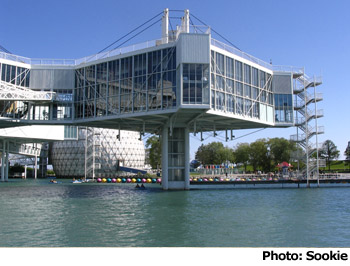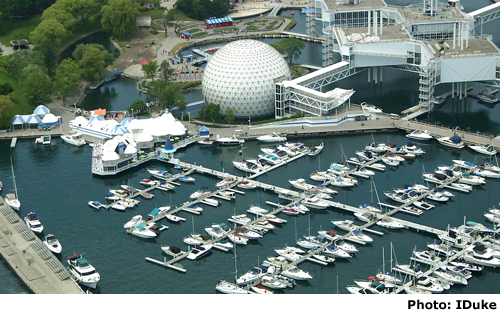
Ontario Place
955 Lakeshore Blvd, Toronto, ON – MODERNIST CULTURAL LANDSCAPE AT RISK
An internationally renowned modernist urban waterfront park has been partially shuttered with no legal protection for its heritage elements, pending a major redevelopment.
 Why it matters
Why it matters
A considerable engineering feat, Ontario Place was considered a futuristic architectural marvel when it opened in 1971. It was designed by one of Canada’s most notable landscape architects, Michael Hough and RAIC gold medalist, architect Eberhard Zeidler. The values of Ontario Place survive in its continued recreational use, park-like waterfront setting, the Cinesphere (a spherical triodetic dome housing Canada’s first IMAX theatre), and its monumental interconnected mast-hung pavilions with bridges and platforms suspended over the water. Together they formed a singular cultural landscape that expressed the avant-garde architectural ideas of the time, including diverse influences such as Archigram, the Metabolists, Pop Art and Expo 67.
Why its endangered
In early 2012, citing financial concerns and declining attendance, the provincial government announced the immediate partial closing of Ontario Place pending a major redevelopment to be completed by 2017. An appointed advisory panel responsible for leading the rehabilitation is taking a “paper is blank” approach where “nothing is off the table.” Without any statutory protection, Ontario Place’s unique cultural landscape with its iconic structures and interconnected design components—that led to its listing on the Docomomo International Selection of buildings, sites and neighbourhoods of the Modern Movement—is at risk. There are no  conditions on what the panel can consider, including leveraging private capital for commercial, retail and residential waterfront condo development on what has been called some of the most expensive land in North America.
conditions on what the panel can consider, including leveraging private capital for commercial, retail and residential waterfront condo development on what has been called some of the most expensive land in North America.
Where it stands
In early June, the advisory panel recommended against using the site for a new Toronto casino. The province intends to begin an international competition later this year on future plans for Ontario Place with a focus on commercial, retail, residential, recreation and entertainment uses. Heritage Toronto and the Architectural Conservancy of Ontario have raised the alarm about the risks to this important cultural landscape, and the “Save Ontario Place” Facebook group has been growing daily.
Latest Update
On July 31, 2014, the province announced that it is moving forward with its “long-term vision to revitalize Ontario Place into a vibrant destination that engages residents and visitors of all ages.”
The first phase of construction of the urban park began in early 2015.
Top 10 Endangered Places
- Explore Past Listings
- National
- British Columbia
- Alberta
- Saskatchewan
- Manitoba
- Ontario
- Our Lady of Assumption Church
- 24 and 28 King Street East, Gore Park
- 24 and 28 King Street East, Gore Park
- Abell
- Alma
- Amherst Island, north-eastern shore of Lake Ontario
- Bala Falls
- Bata
- Davisville Junior Public School/ Spectrum Alternative Senior School
- Districts
- Former Grand Trunk Railways Locomotive Repair Shops
- Gibson Isolation Hospital
- Hamilton Education
- Joachim
- Kingston Collegiate Vocational Institute (KCVI)
- Lister
- Nor’Wester Mountain Range and Loch Lomond Watershed Reserve
- Nottawasaga Lighthouse
- Ontario - Views
- Ontario Place
- Ottawa - Lansdowne Park
- POW Camp 30/Boys Training School National Historic Site
- Petrie Building
- Port Dalhousie
- Somerset House
- The Black Horse Pub and Pig’s Ear Tavern
- Tivoli Theatre
- Views of Legislative Assembly of Ontario Building
- Ontario - Porter/McKinley Block
- Brighton Public School
- Cockshutt
- The Barber Paper Mill
- Bellevue House
- Central Experimental Farm
- Guild Inn
- David Dunlap Observatory and Park
- Riverdale Hospital
- The Old Grand Trunk Railway Station
- Quebec
- New Brunswick
- Nova Scotia
- Prince Edward Island
- Newfoundland and Labrador
- Territories
- Worst Losses Archive
- Nominate a Site
